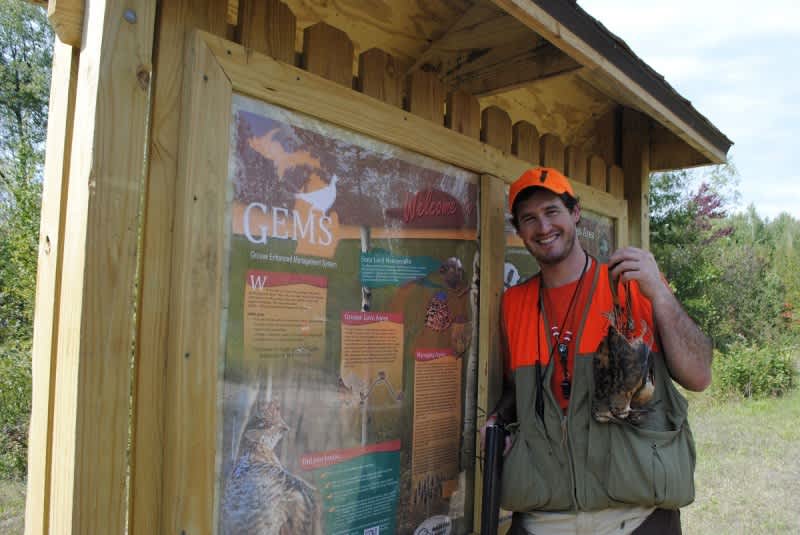Michigan’s GEMS Are a Hunter’s Best Friend
Bob Gwizdz 08.24.15

When the Michigan Department of Natural Resources (DNR) asked for a hunting-license fee increase a couple of years back, it promised to put some of those funds to work improving hunting opportunities. Among the first projects it tackled was upland game bird hunting.
The DNR created a series of walk-in ruffed grouse and woodcock hunting areas called GEMS—Grouse Enhanced Management Sites. The idea was to create trails through high-quality upland bird hunting areas that would be enhanced with additional fruit-bearing plants. They’d also be cut on a shorter rotation to better maintain them as prime grouse and woodcock areas.
The DNR originally identified seven GEMS (five of them in the Upper Peninsula) and will have a total of 14 developed by opening day of grouse season this year.
“Cutting has already taken place on all of our GEMS areas,” said Al Stewart, the DNR’s upland game bird specialist. “The idea is to move these areas from being good habitat for grouse, woodcock, and other young forest wildlife to being excellent habitat for those species.”
GEMS are being developed on state forest land, national forest land, and even on some private (i.e. timber company) land. The DNR has already partnered with three national forests, Plum Creek Timber, the city of Marquette, and the Ruffed Grouse Society to make it happen.
Eric Ellis, the Michigan-based biologist for the Ruffed Grouse Society, said he’s pleased with the program.
“RGS and the American Woodcock Society, our sister group, are both extremely excited,” Ellis said. “We’re doing habitat improvement projects on these sites and using them to promote grouse and woodcock hunting.”
In addition to partnerships, the DNR is enlisting sponsors to help promote GEMS. Sponsors add value by offering donations or in-kind services to their GEMS site (I, for instance, got a 20 percent discount on a box of rifle cartridges at a nearby sporting goods store after spending part of a day hunting the GEMS near Gladwin).
“We see GEMS as places where we can really work with chambers of commerce or other community leaders to help everyone recognize the value of hunting to the economy,” Stewart said. “The local restaurants and gas stations can attract those hunters by sponsoring individual GEMS.”
The DNR has been busily promoting the concept of place-based economics in rural communities. GEMS fit in perfectly.
“Managing habitat for grouse and woodcock generates timber harvest activity, which generates income for local economies,” Stewart said.
Because of its emphasis on foot trails, GEMS will offer recreational opportunity to a wide variety of individuals, said Upper Peninsula wildlife biologist Terry Minzey, who first conceived of GEMS.
“We’re looking at a place for a guy who’s 70 years old and still wants to grouse hunt, but can’t bust the brush anymore,” Minzey said. “Or maybe a guy with a young kid or a wounded warrior, who can’t get through the thick stuff; they can let the dogs go and stay on the trail until the dogs find a bird.
“But GEMS can be used by other hunters—deer hunters or rabbit hunters—or cross-country skiers or snow-shoers or bird watchers. And we’re going to advertise them in all those veins, with the understanding that grouse and woodcock hunting are the center of the conversation.”
Stewart sees GEMS as an educational tool, too.
“There are plenty of people who travel to Michigan from other states to hunt grouse and woodcock,” Stewart said. “GEMS can be a starting point for them. I see these GEMS as sort of demonstration areas. A guy can come to one and see what good habitat looks like. Then they can go online to MIHunt and find similar areas from the comfort of their home or even on-site through their smartphone or iPad. There are 365,000 acres of aspen on state forest land in the [Upper Peninsula] alone. And then there’s the national forest and many of the commercial forest lands that are open to public hunting.”
In addition, GEMS highlight the value of young forests, Stewart said.
“We’re not only promoting their value to the mainstream business culture, we’re providing habitat for a whole suite of species.”
Indeed, it’s estimated that one third of all bird species in Michigan—including some species of concern—utilize early successional forests.
Stewart himself has hunted on five of the seven original GEMS and has done well. On one particular hunt at Lee Grande Ranch in Cheboygan County, he took neophytes and they enjoyed points and shot birds “within a half mile of the parking lot,” he said.
“It was late in the season so a lot of other people had already had the opportunity to hunt there,” he said. “We had good success with both grouse and woodcock.”
For more information on GEMS, click here.
For more information on Michigan hunting go to michigan.org. Click here to purchase a Michigan hunting license online.
This article was produced in partnership with Pure Michigan.

